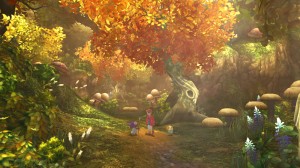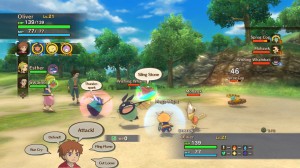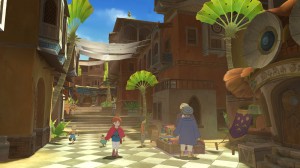E3 2012: Ni no Kuni: Wrath of the White Witch – Hands-on
- Updated: 29th Jun, 2012
Ni no Kuni: Wrath of the White Witch is the role-playing game offspring of wonder parents Level 5 and Studio Ghibli. Each company has an amazing track record in their respective industries with Level 5 best known for their hugely popular Professor Leyton games and Studio Ghibli winning an Oscar for best animated film with their 2002 movie Spirited Away.

The game tells the story of a 13 year old boy called Oliver who ends up exploring the Ni no Kuni or second world thanks to a doll called Drippy and a magic book.
The first game from the world of Ni no Kuni, called Shikkoku no Madoshi was released for the Nintendo DS in Japan way back in 2010 with the PlayStation 3 game, telling a different story following just under a year later. It’s the PlayStation 3 game that’s being translated for release in Europe and North America during Jan 2013.
In the demo, I got to explore a beautifully cel-shaded, plush, green world map littered with towns and monsters. Each monster was dutifully patrolling their own little territories. Unlike the Final Fantasy games, there are no random battles in the world map. You get to see where all the monsters are and you can try to run away from them. It doesn’t always work as sometimes the monsters are just that bit quicker than you. Then at one point I accidentally knocked over Drippy. When the poor little thing got back to his feet he had a little grumpy face emoticon above his head. Oops!
The occasions where I was cornered, or mugged by monsters the game switched into battle mode. In the mode my screen was filled with lots of nicely organised menus. Using these menus I could do everything from casting my spells to inflicting physical attacks, reposition my party members to make best use of their skills and using or examining any items stored in their backpacks.

Happily enough, I had enough time to flick through the menus to decide on my attacks without feeling too rushed. That didn’t mean the battles were long, drawn-out affairs. On the contrary, everything was wrapped up quickly following my flurry of all out attacks including some lovely flame spells. This banzai tactic won’t work on higher level monsters but it was fun all the same.
Something I learnt after playing the demo is that each party member can use up to three creatures during the fights, courtesy of one of your team’s creature recruiting powers. Ultimately, this means you could have three party members and nine creatures to manage during each monster battle. That should keep you busy!
When I stumbled upon the town of Ding Dong Dell I could wait to explore it. Unfortunately, in this particular town I wasn’t able to talk to any of the non-playable characters or uncover any of the plot. Instead, I made do with the beautiful art design and got to play with a few of the items from one of shops. After spending a while darting in and out of people’s houses and wandering around streets, the look of the game is very Studio Ghibli. In fact, I felt like I was inside one of their films.
I didn’t get to hear much of the in-game music either – composed by Studio Ghibili’s Joe Hisashi – because of the overwhelming noise from the rest of the E3 show floor. Just have a listen to the fantastic music he composed for Ni no Kuni: Shikkoku no Madoshi.
After playing the short demo I asked Dennis Lee, Senior Brand Manager at Namco Bandai about how much input Studio Ghibli had into the development of the game. He said that “when Level 5 was still creating the story and the characters, they reached out to Studio Ghibli to see if they wanted to be involved in the game. They showed them some early concepts and from that point on they were able to have input from the game itself.”
This isn’t just a game for hardcore Studio Ghibli fans either. According to Lee, Level 5’s focus was on “was making an interactive adventure and experience that appeals to as wide an audience as possible. They didn’t want to create a game targeted to Studio Ghibli fans or just to Dragon Fans or RPG fans. From the characterisations, everything appealing to younger kids but at the same time having storylines that appeal to the adults.

I also asked Lee about how the game deals with saving your progress, as some RPGs handle this very badly like The Legend of Zelda. He said that “in the majority of game areas you are able to save pretty much where ever you want.” He went on to say that “there are certain areas, that are not really called this, but feel more like dungeons. If they [player] are in a dungeon, they may have to get to the next save point or run back to the previous one. But the game is set up to so you aren’t going to spend 5 hours in a dungeon trudging along, die and then you have to continue back where you were.” It’s good to hear that you can save almost anywhere in Ni no Kuni as I stopped playing Zelda games because of their frustrating save system.
Ni no Kuni: Wrath of the White Witch is a captivating game. It boasts a beautiful world populated by colourful characters. I only hope that the plot and dialogue hold up to the quality of the visuals as I can see myself getting lost in its magical world for hours and hours. The only downside is having to wait until next year to play it.
Ni no Kuni: Wrath of the White Witch will be released on the 25th Jan 2013 for PlayStation 3.

Follow Us!